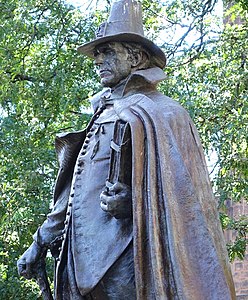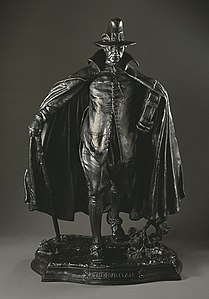The Puritan (statue)

The Puritan is a bronze statue by sculptor
History


In 1881,
The sculpture, cast at the
In 1983, City Councilor Mary Hurley sought to restore the statue to its original location in Stearns Square. This move was initiated in part due to the restoration of the Turtle Fountain and other fixtures at that location, but the proposal lacked support. Then-mayoral candidate Richard Neal opposed the move, as did the descendants of Deacon Chapin, arguing that the statue had become a fixture of the Quadrangle's museums and that the original move had rescued it from vandalism during its short stay in Stearns Square.[6][7]
The sculpture now stands next to the Springfield City Library built in 1912. The base is inscribed:
1595 Anno Domini 1675
Deacon Samuel Chapin
One Of The Founders Of Springfield
Likeness
No authentic portraits of Deacon Samuel Chapin were available for the statue's design. The
In 2014,
Saint-Gaudens remains best known for his Civil War memorial works, including the

Popularity
The statue was so popular that Saint-Gaudens, seeing a business opportunity, decided to produce smaller versions under the title The Puritan. Today more than 25 slightly altered copies can be found in museums, art galleries, universities, and private collections around the world.
The New England Society of Pennsylvanians commissioned a replicas, with some changes in the figure's dress and face: "For the head in the original statue, I used as a model the head of Mr. Chapin himself, assuming that there would be some family resemblance with the Deacon, who was his direct ancestor. But Mr. Chapin's face is round and Gaelic in character, so in the Philadelphia work, I changed the features completely, giving them the long, New England type, besides altering the folds of the cloak in many respects, the legs, the left hand, and the Bible." The copy, dubbed The Pilgrim, was placed on the South Plaza of City Hall, then relocated to its present site in Fairmount Park in 1920.[9]
Gallery
-
Photograph of the statue in Springfield, by the Detroit Publishing Company (1905).
-
Part of The Puritan by Augustus Saint-Gaudens
-
A copy of the larger sculpture by Augustus Saint-Gaudens in the Smithsonian, with differences from the Springfield original.
-
A copy of the statue in the Los Angeles County Museum of Art
-
The Pilgrim, the Philadelphia replica of The Puritan.
-
An illustration of one of Saint-Gaudens' copies, used to promote a so-named Chapin National Bank in 1923
-
The statue on the reverse side of the city's 275th anniversary medallion
In popular culture
- The statue plays a pivotal role in the plot of the 1975 mystery-drama The Reincarnation of Peter Proud, directed by J. Lee Thompson. In the film, protagonist Dr. Peter Proud, a professor in California, is haunted by visions of a town in Massachusetts from a past life, with particular focus on The Puritan statue and Springfield's South Congregational Church.
- A rendition of The Puritan is emblazoned in the center of Springfield's flag, adopted by the city in 1923.[1]
- The comedy Wednesday features a statue similar to The Puritan.
See also
- 54th Massachusetts, the first African-American regiment organized in the northern states during the Civil War
- Miles Morgan, a contemporary of Samuel Chapin whose likeness is depicted in a statue near the Springfield Municipal Group by Jonathan Scott Hartley
References
- Bach, Penny Balkin. Public Art in Philadelphia Temple University Press, 1992. Philadelphia PA.
- Burt, Henry M. The First Century of the History of Springfield: the Official Records from 1636 to 1736, with an Historical Review and a Biographical Mention of the Founders, Volume I Henry M. Burt, 1898. Springfield MA. full text online
- Dryfhout, John H. The Work of Augustus Saint-Gaudens University Press of New England, 1982. Lebanon NH.
- Metropolitan Museum of Art, The. "Heilbrunn Timeline of Art History". Metropolitan Museum of Art, 2000. New York NY.
- Tolles, Thayer. "Augustus Saint-Gaudens in The Metropolitan Museum of Art". The Metropolitan Museum of Art Bulletin, v. 66, no. 4 (Spring, 2009). New York NY.
Notes
- ^ a b "City of Springfield, MA Seal and Flag". eCode 360. Archived from the original on 10 March 2016. Retrieved 13 May 2017.
- ^ a b Dryfhout, p. 162.
- ^ Burt.
- ^ The Puritan, (sculpture). Siris-artinventories.si.edu. Retrieved on 2013-08-21.
- ^ "The Statue of Dea Samual Chapin". Springfield Republican. Springfield, Mass. July 28, 1886. p. 5.
Augustus St Gaudens, the sculptor of the Chapin statue, has been in town looking at possible sites for his work. He disapproves wholly of Court square, but is favorably inclined toward the city library grounds...A position on the city library grounds, on the contrary, would exhibit the artist's intent to the best advantage
- ^ "Opinion -- Don't disturb The Puritan". Springfield Union. Springfield, Mass. October 1, 1983. p. 14.
- ^ Nelson, Nancy L. (November 23, 1987). "Deacon Chapin ignores 100th birthday party". Springfield Union-News. Springfield, Mass. p. 13.
- ^ ISBN 9781584657095.
- ^ a b Bach
- ^ Gardner, Eugene Clarence (1905). Springfield Present and Prospective: The City of Homes. Pond & Campbell. p. 54.
The statue is no portrait of any Chapin, but a composite in the sculptor's mind of the family type, and fitly given the ideal name, 'The Puritan'
- ^ "The Puritan; The Deacon Chapin Statue at Springfield, Mass". Milwaukee Journal Sentinel. Milwaukee. November 15, 1887. p. 2.
The face is a sort of composite–made up by a study of the family features of the Chapins
- ^ a b Jendrysik, Stephen (January 22, 2014). "Stephen Jendrysik: Is Augustus Saint-Gaudens' 'The Puritan' statue really John Brown in disguise?". The Republican. Springfield, Mass. Archived from the original on July 8, 2018. Retrieved July 8, 2018.
- ^ "Eighth Generation". The Chapin Book of Genealogical Data. Vol. II. Hartford, Conn.: Chapin Family Association. 1924. p. 1655.
- ^ Cowan, Wes (December 6, 2007). "Cowan's Auctions". Archived from the original on June 24, 2010. Retrieved December 5, 2010.
- ISBN 978-0-7910-8340-6.
- ^ "[Advertisement for] Massasoit Insurance Company". Newcomb's Springfield Directory, to 1858-1859. Springfield, Mass.: J. M. Newcomb. 1858. p. LVI.
Directors:...Chester W. Chapin...Ethan S. Chapin
- ^ Phaneuf, Wayne (May 23, 2011). "Springfield's Massasoit House housed the famous". The Republican. Springfield, Mass. Archived from the original on April 19, 2019.
The years before the Civil War were profitable ones for the hotel and its proprietors, who were ardent anti-slavery men. They may have been swayed by John Brown, the famous abolitionist, who roomed at the Massasoit House before moving his family to Springfield in the late 1840s
- ^ "Chester W. Chapin". Springfield Republican. Springfield, Mass. June 11, 1883. p. 5.
He was a working member of the constitutional convention of 1853, held sundry town and city offices, and good-naturedly consented to run for Congress several times when there was no possible chance for one of his part to be elected. He was a war democrat, and largely paid for the uniforms of the City guard when that organization joined the 10th regiment.
- ^ ISBN 9780307486660.
- ^ ISBN 9781532635960.
- ^ Cox, Samuel Sullivan (1865). Eight Years in Congress, from 1857-1865. New York: D. Appleton and Company. p. 287.
- ^ Stauffer, John; Soskis, Benjamin (2013). The Battle Hymn of the Republic: A Biography of the Song That Marches On. Oxford University Press. p. 317.
In his reminiscences, Saint-Gaudens recalls a moment 30 years before, when the same song had moved him nearly as much as it had during the monument's unveiling. While apprenticing for a cameo cutter with an office on Broadway, he had watched New England volunteers marching by, singing "John Brown's Body".
- ^ Tolles
- ^ "The Puritan". Museum of Fine Arts Boston. Archived from the original on December 4, 2018.
- ^ "The Puritan". The Met. The Metropolitan Museum of Art. Archived from the original on September 8, 2017.
- ^ "The Puritan". Smithsonian American Art Museum. Archived from the original on December 4, 2018.
- ^ 99th Anniversary Celebration of the New England Society in the City of New York (Report). New England Society of New York. 1904.
- ISBN 978-0-674-62840-3.
- ISBN 978-0-943161-35-8.
External links
- Metropolitan Museum of Art Discussion of the sculpture's history.
- Augustus Saint-Gaudens, Master Sculptor, exhibition catalog fully online as PDF from The Metropolitan Museum of Art, which contains material on The Puritan















